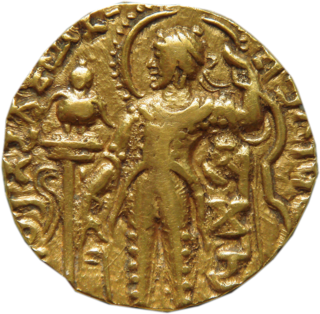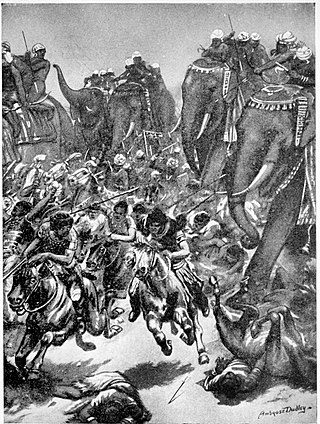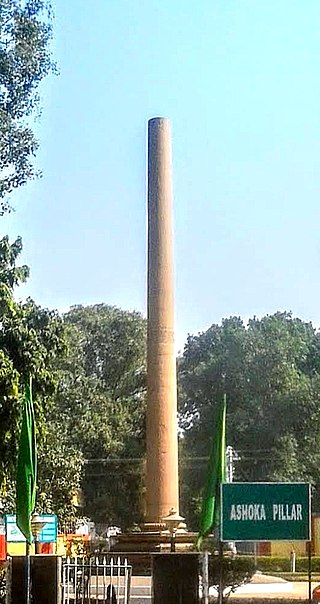The Gupta Empire was an ancient Indian empire on the Indian subcontinent which existed from the mid 3rd century CE to mid 6th century CE. It was the seventh ruling dynasty of Magadha. At its zenith, from approximately 319 to 467 CE, it covered much of the Indian subcontinent. This period has been considered as the Golden Age of India by historians, although this characterisation has been disputed by some other historians. The ruling dynasty of the empire was founded by Gupta and the most notable rulers of the dynasty were Chandragupta I, Samudragupta, Chandragupta II, Kumaragupta I and Skandagupta.

Chandragupta II, also known by his title Vikramaditya, as well as Chandragupta Vikramaditya, was the third ruler of the Gupta Empire in India. Modern scholars generally identify him with King Chandra of the Delhi iron pillar inscription.

Chandragupta I was a monarch of the Gupta Empire, who ruled in northern and central India. His title Mahārājadhirāja suggests that he was the first suzerain ruler of the dynasty. It is not certain how he turned his small ancestral kingdom into an empire, although a widely accepted theory among modern historians is that his marriage to the Licchavi princess Kumaradevi helped him extend his political power. Their son Samudragupta further expanded the Gupta empire.

Samudragupta (Gupta script: Sa-mu-dra-gu-pta, was the second emperor of the Gupta Empire of ancient India, and is regarded among the greatest rulers of India. As a son of the Gupta emperor Chandragupta I and the Licchavi princess Kumaradevi, he greatly expanded his dynasty's political and military power.

Gupta was the founder of the Gupta dynasty of northern India. He is identified with king Che-li-ki-to, who, according to the 7th-century Chinese Buddhist monk Yijing, built a temple near Mi-li-kia-si-kia-po-no (Mṛgaśikhāvana) for Chinese pilgrims.

The Gupta script was used for writing Sanskrit and is associated with the Gupta Empire of the Indian subcontinent, which was a period of material prosperity and great religious and scientific developments. The Gupta script was descended from Brāhmī and gave rise to the Śāradā and Siddhaṃ scripts. These scripts in turn gave rise to many of the most important Indic scripts, including Devanāgarī, the Gurmukhī script for Punjabi, the Odia script, the Bengali-Assamese script and the Tibetan script.

Yashodharman was the ruler of the Kingdom of Malwa, in Central India, from 515 until his death in 545. He belonged to the Second Aulikara dynasty. He conquered much of the Indian subcontinent between c. 530–540 according to the Mandsaur pillar inscription.

Kamarupa, an early state during the Classical period on the Indian subcontinent, was the first historical kingdom of Assam. The Kamrupa word first appeared in the Samudragupta Allahabad Edict before that there is no mention of existence of this word.

The Varman dynasty (350–650) was the first historical dynasty of the Kamarupa kingdom. It was established by Pushyavarman, a contemporary of Samudragupta. The earlier Varmans were subordinates of the Gupta Empire, but as the power of the Guptas waned, Mahendravarman (470–494) performed two horse sacrifices and the status of Kamarupa as an independent state remained unimpaired. As per the Apsad Inscription of Adityasen, Susthivarman was defeated by Mahasengupta on the bank of Lauhitya. The first of the three Kamarupa dynasties, the Varmans were followed by the Mlechchha and then the Pala dynasties.

The Salankayana dynasty of ancient India ruled a part of Andhra region in India from 300 to 440 CE. Their territory was located between the Godavari and the Krishna rivers. Their capital was located at Vengi, modern Pedavegi near Eluru in West Godavari district of Andhra Pradesh.
The Malavas or Malwas were an ancient Indian tribe. They are believed to be the Mallian people (Malloi) who lived in the Punjab region at the time of Alexander's invasion in the 4th century BCE. Later, the Malavas migrated southwards to present-day Rajasthan, and ultimately to Madhya Pradesh and Gujarat. Their power gradually declined as a result of defeats against the Western Satraps, the Gupta emperor Samudragupta, and the Chalukya emperor Pulakeshin II.

Samataṭa was an ancient geopolitical division of Bengal in the eastern Indian subcontinent. The Greco-Roman account of Sounagoura is linked to the kingdom of Samatata. Its territory corresponded to much of present-day eastern Bangladesh and parts of the Rakhine State of Myanmar. The area covers the trans-Meghna part of the Bengal delta. It was a center of Buddhist civilisation before the resurgence of Hinduism, and Muslim conquest in the region.
There are conflicting theories regarding the original homeland and ancestry of the Gupta dynasty that ruled northern India between 4th and 6th centuries. Modern historians variously theorize that it originated in present-day Uttar Pradesh or Bengal, based on epigraphic, numismatic and literary evidence. The social group (varna) of the dynasty is also a matter of debate, with scholars variously placing them in Vaishya, Brahmana, or other categories.
Pakhanna is a village in the Barjora police station area of Bankura Sadar subdivision of Bankura district in the Indian state of West Bengal. It is located 40 kilometres (25 mi) north-east of Susunia, on the south bank of Damodar River.

The Allahabad pillar is a stambha, containing one of the pillar edicts of Ashoka, erected by Ashoka, emperor of the Maurya dynasty, who reigned in the 3rd century BCE. While it is one of the few extant pillars that carry Ashokan edicts, it is particularly notable for containing later inscriptions attributed to the Gupta emperor Samudragupta. Also engraved on the stone are inscriptions by the Mughal emperor Jahangir, from the 17th century.

Kacha was a king of India, possibly a member of the Gupta dynasty. He is known only from his gold coins, which are similar to those of the Gupta king Samudragupta.

Sridharavarman was a Saka (Indo-Scythian) ruler of Central India, around the areas of Vidisa, Sanchi and Eran in the 4th century CE, just before the Gupta Empire expansion in these areas. He calls himself a general and "righteous conqueror" in an inscription, and Rajan ('King') and Mahaksatrapa in a probably later inscription at Eran, suggesting that he may have been a high-ranked officer who later rose to the rank of a King.
The Abhira dynasty was a dynasty that ruled over the western Deccan, where it perhaps succeeded the Satavahana dynasty. From 203 to roughly 270 or 370, this dynasty formed a vast kingdom. The Abhiras had an extensive empire comprising modern-day Maharashtra, Konkan, Gujarat and parts of southern Madhya Pradesh. Some scholars regard the Abhiras as a great almost an imperial power in the third century A.D.

The Gupta-Saka Wars refers to the military conflict between the Gupta Empire, ruled by Chandragupta II, and the Western shatrapas, also known as the Shakas, during the 4th century CE.












